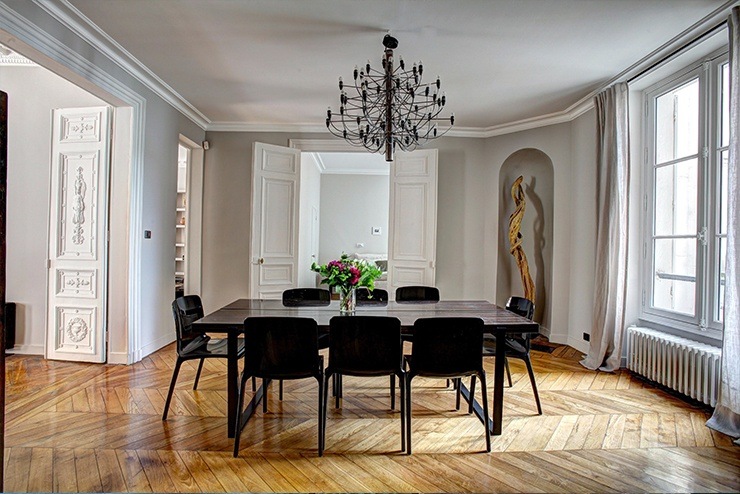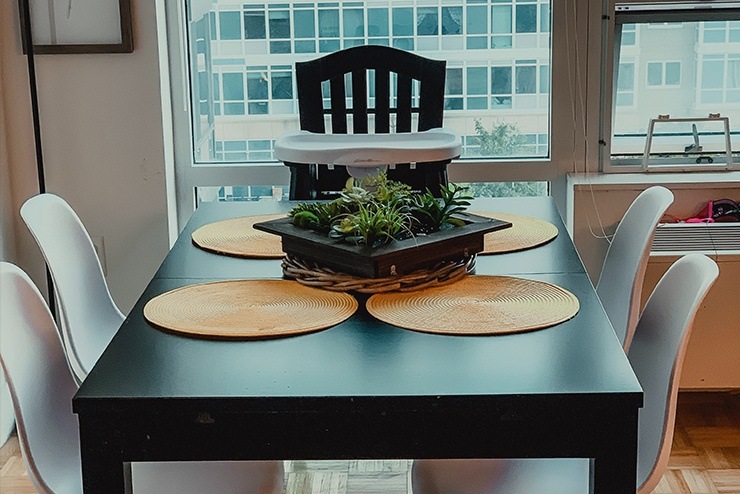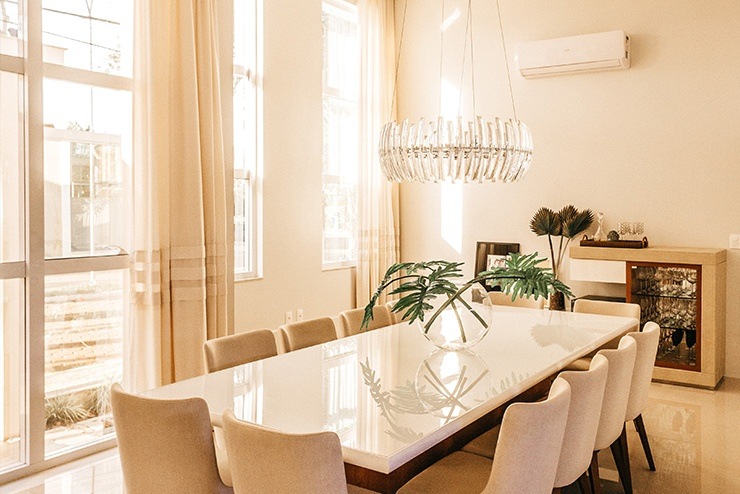Dining Table Staging
5 Clever Tips for Staging a Dining Room
Updated: | Categories: Dining Room

When you're staging a home, there are a number of different philosophies and strategies that will come into play, and staging a dining room is no different.
When you're trying to make this space appeal to a wide number of people, it's about showing the potential of the room and home while also leaving enough up to the imagination where people will fill in their own blanks to make it suit their taste, their wants, and their needs.
The dining room is one of the more important rooms when it comes to staging, right behind the living room, bedrooms, outdoors, and the kitchen. Homes without a dining room can take longer to sell, even though many families don't actually use their dining room for formal family dinners.
5 Dining Room Staging Tips
Regardless of how you've used your dining room, when it's time to sell your home (or live in it), you've got to put yourself in the shoes of a buyer and think about what they want to see. That's a key to decorating. We may not think we know what looks good, but we know what others might think looks good.
Avoid Clutter in Your Dining Room Staging & Keep it Simple

To expand on something I've already mentioned, a huge part of staging is about laying down a solid foundation and letting the potential homebuyers connect the dots to suit their own style and desires.
You don't want to give them a window into your life (or the best-presented version of your life)... you want them to give a frame to paint their own vision of the room.
It's not an easy thing to accomplish, but keeping away trinkets and any personal things of yours will help give them a blank palette. You'll still be making design choices during the other steps of the staging process, but a more neutral approach is a good strategy.
Now, don't take this advice to say that I want you to turn your dining room into a sterile hospital room or anything like that.
You can have flourishes, you can have things in the room, but when it comes to avoiding clutter, just make sure you don't have a bunch of your belongings laying around, paperwork spread out on the table, and so on.
We're about to talk about the dining room table, but there's some overlap with this section where I want to include a really useful tip.
In the next section, I'll recommend using four dining room chairs, but there's a little more to this. Removing some extra chairs, even if they're usually around the table, does a great deal to help the room feel larger and more open.
Staging a Dining Room Table

You can't think about how to stage a dining room without thinking about the table. The dining room table is the heart of this room. This is where people will picture themselves sitting around, eating, enjoying their time.
It's usually a good idea to stick with the standard four chairs around the table to keep clutter to a minimum, but if you have a giant dining room table in a large dining room, then more chairs is perfectly fine.
This is one of the finer points of how to stage a dining room table, and not everybody is on the same page, so you'll want to figure out what looks best in your home.
Small succulents or cactus plants can look great on the table, but there are a number of different displays you can put together. If your table is in good shape, or you're renting one, then it can look great to keep it simple without a tablecloth - maybe just use a runner across the middle of the table so that you can place your little display/centerpieces on that.
You may or may not want to have a rug surrounding your dining room table. If you have a chandelier in your dining room, you'll want to place the rug directly below it, centered, with the table centered on top of the rug.
This won't work for every dining room especially depending on the types of rugs you have, but if you have these features, that's a really useful rule of thumb to get you started.
For staging a small dining room, the best thing you can do is to choose a smaller table. Round tables work great for smaller rooms because they make the room look more open and make it easier to move around while viewing the room.
In a larger room, you obviously have a lot more options. In a smaller room, you'll want to get rid of anything that isn't necessary, because a room that looks larger and more open will almost always be more appealing to buyers than a cramped room, even if the cramped room is full of cool things.
You want the buyer to picture their own things in the room because this brings them one step closer to making an offer.
You should also set the table with nice silverware and plates, fine napkins, and the whole nine yards. Do you know how many people would be living in the house? You can set the appropriate amount of places at the table depending on who the potential buyer is and the types of tables you may have.
This is just an extra subtle step, a little cherry on top that they may or may not consciously notice, but on some level it gives them an additional connection to the home, all thanks to the small things you do while staging a dining table.
Clean The Dining Room Like Crazy
Depending on how clean your home is by default and how recently you've been living in it before staging, this may or may not be the most relevant point. In any case, it should go without saying that you'll want to make this room (and every room) as clean as possible.
I'm not just talking about dusting and wiping down the table. It should be immaculate. The walls should be wiped down so there aren't any shiny grease marks in the light, you'll want to polish the floor, and you'll want to get any little piece of dust or crumbs from the corners.
If you have a rug, you may want to have it cleaned, or at least give it a good vacuuming. Carpet stains are no good, so make sure that you deal with those too.
The short answer is to clean everything and to do a very good job of cleaning it. Hiring a professional cleaner is relatively inexpensive, especially if it frees you up to focus on the other aspects of selling a home.
Make a List of Touch-Ups in the Dining Room Area
It helps to start with an empty room if you're staging from scratch rather than trying to get your current furnishings as tidy as possible. If you're living in space, you won't really have this luxury.
If the home is empty and you're renting staging furniture, you have more leeway here. But in any case, you should go over the room from top to bottom (it's easier to do this while cleaning) and take note of every little thing that's not quite perfect that isn't a cleaning-related issue.
For example, if the paint is chipped in certain areas, if the floorboards are painted sloppily, if a light switch is cracked, if you need to hide exposed pipes, and so on. You'll be going over every inch of the room to clean anyways, so you may as well take notes as you're going.
If not, it's easy to forget some little detail since you're so used to seeing it in your home, but it could stand out for a buyer that's never seen the space before and is observing with a critical eye.
Lighting is Everything When Staging a Dining Room

The lighting in a room makes such an incredible difference in how it looks. Just tossing up a white bulb isn't enough, you'll want to choose a warmth that matches the room.
A lightbulb can range from a bright, blueish, clinical feeling to a warm, toasty orange. It's not a bad idea to get a couple of different bulbs if you're able to easily switch bulbs in your dining room in order to see which tones suit the room best.
It's not just about choosing bulbs, though, because the fixtures are also very important. Not only are lighting fixtures a nice way to add an accent to the style of the room, but they'll decide which areas in the room are brighter lit.
The way the light hits art, the walls, furniture and anything else in the room plays a role in the overall aesthetic and appeal of the room. You don't have to go crazy with it, just be mindful of lighting and how it will affect everything else you're doing to stage the room.
Besides light fixtures and bulbs, you'll also want to harness the natural light of the room. Make sure that your dining room window (if you have one) is letting in as much light as possible from outside, especially if you're showing the home during the day.
If you have an appropriate area on the wall across from your window, you could install a mirror. This will help to further brighten up the room. If you feel like your dining room is too small and lacks light, a nice mirror can really help with both issues.
Good Luck Staging a Dining Room!
I think you're going to do a great job. For all of the tips and advice I've shared on the topic of staging a dining room, I always like to remind people that very little of it is actually written in stone.
Different types of houses call for different style choices. Different countries or communities will have their own styles, and at the end of the day all I can do is share my best rules of thumb and guidelines, but you'll be the person who is standing in the room and deciding how it looks - so take what I've taught you about dining room staging and run with it!
You'll Also Enjoy:
- Family Room vs Living Room: Is There Even a Difference?
- Types of Coffee Makers: Choosing Correctly & Why It Matters
- How to Secure a Sliding Glass Door: Easy Security Options
- 14 Drywall Alternatives That Bring Life to a Dull Room
- 28 Kitchen Sink Ideas to Impress While Best Utilizing Your Space
Editor: Rick Worst
 Rick is a home design consultant and enthusiast, whose life is consumed by all things home and garden. Started as a hobby, Worst Room has grown into an information and inspiration wheelhouse for professionals and home owners alike. Rick serves as owner and editor for our many content contributors. Learn more about Rick & the Worst Room operation here.
Rick is a home design consultant and enthusiast, whose life is consumed by all things home and garden. Started as a hobby, Worst Room has grown into an information and inspiration wheelhouse for professionals and home owners alike. Rick serves as owner and editor for our many content contributors. Learn more about Rick & the Worst Room operation here.
Source: https://worstroom.com/staging-a-dining-room/
